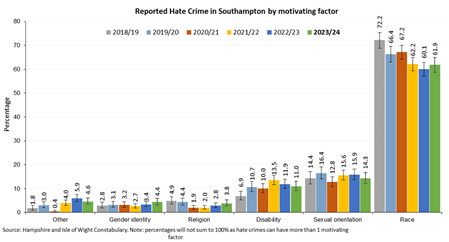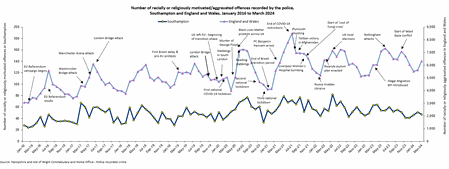
Hate crime
 Hate crime
Hate crime
Hate crime is defined as ‘any criminal offence which is perceived, by the victim or any other person, to be motivated by hostility or prejudice towards someone based on a personal characteristic’ (Home Office). There are five monitored strands of hate crime:
- Race or ethnicity
- Religion
- Sexual orientation
- Disability
- Transgender identity
 There were 937 recorded hate crime offences in Southampton during 2023/24, a -15.3% decline from 2022/23, with Hampshire and Isle of Wight Constabulary experiencing a similar decline (-16%). Across England and Wales hate crime declined by -5% in 2023/24 compared to the previous year; the second annual decline recorded since 2012/13.
There were 937 recorded hate crime offences in Southampton during 2023/24, a -15.3% decline from 2022/23, with Hampshire and Isle of Wight Constabulary experiencing a similar decline (-16%). Across England and Wales hate crime declined by -5% in 2023/24 compared to the previous year; the second annual decline recorded since 2012/13.
A hate crime can have multiple motivating factors (strands). Race continues to be the most frequently recorded motivating factor of hate crime in Southampton (61.9% in 2023/24), with the Home Office also finding the majority of hate crimes across England and Wales to be racially motivated (70%). The second most frequent motivating factor in Southampton is sexual orientation (14.3%), followed by disability (11%).
The main drivers for increases in hate crime in the last decade, are thought to be greater public confidence to report hate crime and improvements in police recording. Hate crime in Southampton has experienced a decline for the second consecutive year.
The fall in hate crimes seen nationally in the last two years have been linked with the publication of interim guidance on the recording of non-crime hate incidents (NCHIs) by the College of Policing in 2022, which was later updated in June 2023. This guidance, which followed interim guidance published in 2022, instructed officers to consider whether genuine hostility occurred or if an incident could be free speech. Whilst this was aimed only at the recording of NCHIs, it is possible that the guidance may have led to greater scrutiny of what constitutes a hate crime. Home Office counting rules for hate crime has not changed. Therefore, fewer hate crimes being recorded over the last two years may not reflect a genuine decline.
 There is evidence to suggest that there have been short-term genuine rises in hate crime following trigger events, such as terrorist attacks or political events. For example, increases in hate crime were seen around the EU Referendum in June 2016, terrorist attacks in 2017 and the Black Lives Matter protests and far-right counter protests in summer 2020.
There is evidence to suggest that there have been short-term genuine rises in hate crime following trigger events, such as terrorist attacks or political events. For example, increases in hate crime were seen around the EU Referendum in June 2016, terrorist attacks in 2017 and the Black Lives Matter protests and far-right counter protests in summer 2020.
Hampshire and Isle of Wight Constabulary note that there are greater concentrations of hate crime in densely populated and deprived areas, with neighbour disputes and the night-time economy cited as common triggers. This continues to be evidenced locally, with the highest rate of hate crimes recorded in Bargate ward (8.6 hate crimes per 1k population), followed by Banister & Polygon (5.2 per 1k) and Freemantle (5.1 per 1k) wards. All of which had significantly higher rates of hate crime compared to the Southampton average (3.5 hate crimes per 1k population).
A summary report and slide set produced as part of the 2023/24 Strategic Assessment are available to download below. The interactive community safety dashboard can be accessed using the link below. For more information on crime in Southampton, see the Safe City Strategic Assessment page.
Resources
2023/24 Safe City Strategic Assessment
The Southampton Safe City Strategic Assessment provides an overview of current and future crime, disorder and community safety issues affecting Southampton and makes recommendations to enable the Partnership to focus the Safe City Strategy and local delivery plans. The report and slide set that informed the assessment are available below to download. The interactive community safety dashboard can be accessed using the link below.
Archived assessments
This section contains archived reports from previous Safe City Strategic Assessments. For the latest report and data on crime and community safety in the city, see the Safe City Strategic Assessment above.
Home Office - Hate crime, England and Wales
The Home Office publish an annual report containing statistics about hate crime offences recorded by the police in England and Wales. The report most relevant to the latest Southampton Safe City Strategic Assessment is linked below.
Last updated: 06 January 2025